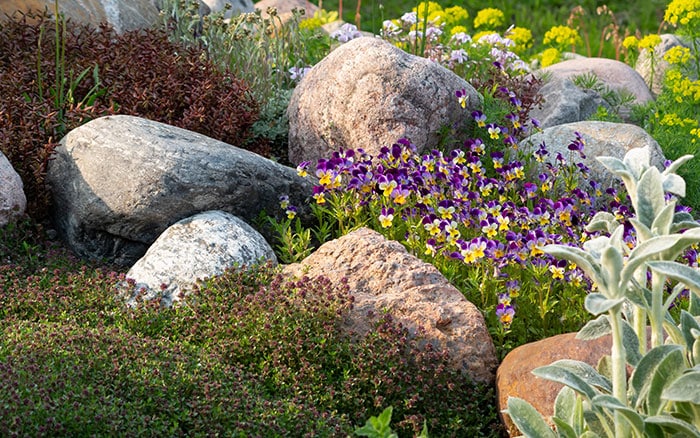Rockeries are fantastic for adding structure and variety to your garden.
A rockery, or rock garden, is an elevated bed or border built of large rocks and soil with plants growing in between. It’s a great opportunity to grow alpine plants, which thrive in these small sloping areas amongst the rocks.
Create your own
You can create a rockery in any space you choose. From large beds to miniature rock gardens in containers. So no matter how small or large your space, you should have room to make this a feature in your garden. They’re also a great solution for sloping or steep areas of your garden.
Hold up
Once you’ve selected the site for your rockery, you’ll need some large rocks to use as ‘anchors’. It’s best to source rocks that are native to the area you live in. For example sandstone in Central England, or slate from Wales. Decorative aggregate suppliers will sell what you need. But you can also check local quarries and landscape dealers to see what’s available in your area.
Fabric
You’ll also need some weed or landscape fabric. Lay underneath your rockery to prevent rocks from slipping down into the ground, improve drainage and suppress weeds. Add pebbles or gravel, and some alpine compost mix. You can usually buy alpine compost mix from garden centres. Or you can make your own by mixing together equal parts topsoil, horticultural grit and leaf mould.
Mark out
To begin making your rockery, mark out the area using pegs and string and then clear all weeds. Put down a layer of pebbles or gravel and then lay the weed fabric over the top. Next, pour on some alpine compost and arrange your large ‘anchor’ stones, burying them down to one third underneath the soil and two thirds above. Place the rocks on different levels and facing in varying directions to add interest to your rock garden.
Plants
When choosing plants for your rock garden, look for ‘Alpines’ – they’re hardy, low-maintenance plants that will thrive in this rocky climate. They’re often drought tolerant too, which all helps to conserve water in the garden. Aubretia is a classic example of a creeping alpine plant that will bring masses of pretty purple flowers in amongst the neutral greys of your rocks. Sedum (sometimes called stonecrop) is also a great choice, with its unusual succulent leaves and clusters of flowers that come in a variety of colours. Or you could try gentiana verna for a carpet of blue flowers or saxifrage for lots of lovely greenery and colourful summery flowers. Anacyclus, alpine campanula, creeping thyme and dianthus are some more options of alpines that would work well in a rock garden.
Arrangements
Once you’ve selected your plants and got them home, arrange them around the rocks to see what they look like. Don’t worry if the rocks seem to stand out a lot at first – they’ll soon naturally gather moss and lichen and for added colour and interest.
Think about
Try to consider your plants needs when you’re deciding where they will go – check whether they prefer full sun or partial shade and plant accordingly. Large rocks can even provide shelter for some plants, with the angle of the rocks creating different micro-climates in your rock garden. Once you’re happy with the arrangement, remove the plants from their pots and plant them in the soil surrounding the rocks, firming in gently and watering in well.
The final step is to add a layer of gravel or pebbles to surround your plants. This gives the rock garden a nice ‘finished’ look but also serves as a mulch to retain water for your plants. The gravel also brings a variety in texture with the smaller pebbles complementing the larger rocks and adding to the overall landscape.
Slugs
Sharp gravel even has the potential to deter slugs, that won’t like its jagged edges. This can be especially beneficial to alpine plants whose fleshy leaves are particularly attractive to slugs and snails.
Your rock garden is now complete! This new feature in your garden will hopefully bring added variety and interest to your outdoor space with an unusual, attractive and low maintenance space that you can enjoy for years to come.



Leave A Comment